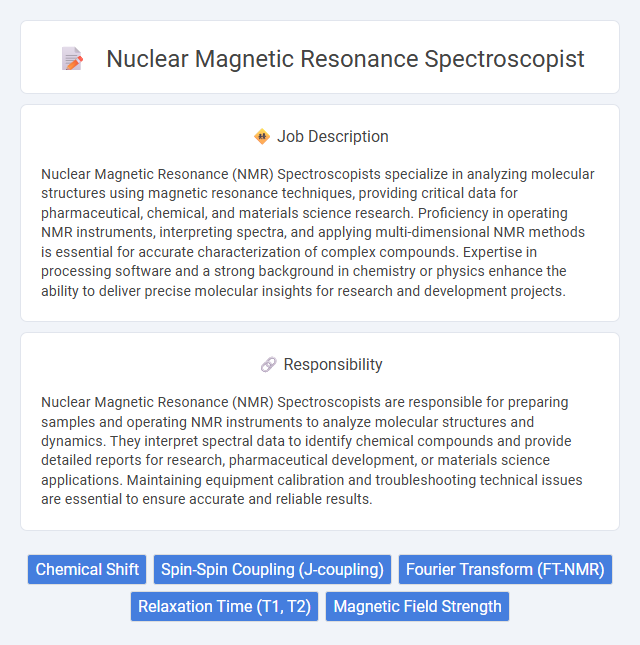
Nuclear Magnetic Resonance (NMR) Spectroscopists specialize in analyzing molecular structures using magnetic resonance techniques, providing critical data for pharmaceutical, chemical, and materials science research. Proficiency in operating NMR instruments, interpreting spectra, and applying multi-dimensional NMR methods is essential for accurate characterization of complex compounds. Expertise in processing software and a strong background in chemistry or physics enhance the ability to deliver precise molecular insights for research and development projects.
Individuals with strong analytical skills and a keen eye for detail are likely to excel as Nuclear Magnetic Resonance Spectroscopists, as the role demands precise interpretation of complex data. Those comfortable working in a laboratory environment with sophisticated instrumentation may find this job suitable, while candidates who prefer non-technical or less structured settings might face challenges. The probability of success increases for individuals possessing patience, problem-solving abilities, and a background in chemistry or related sciences.
Qualification
A Nuclear Magnetic Resonance (NMR) Spectroscopist typically requires a minimum of a bachelor's degree in chemistry, physics, or a related field, with many positions favoring a master's or Ph.D. in analytical chemistry or biophysics. Proficiency in operating advanced NMR instruments, interpreting complex spectral data, and experience with software tools like TopSpin or Mnova are essential qualifications. Strong analytical skills, attention to detail, and a thorough understanding of molecular structure and dynamics enhance job performance and are highly sought after by employers.
Responsibility
Nuclear Magnetic Resonance (NMR) Spectroscopists are responsible for preparing samples and operating NMR instruments to analyze molecular structures and dynamics. They interpret spectral data to identify chemical compounds and provide detailed reports for research, pharmaceutical development, or materials science applications. Maintaining equipment calibration and troubleshooting technical issues are essential to ensure accurate and reliable results.
Benefit
Nuclear Magnetic Resonance (NMR) Spectroscopists likely experience significant professional benefits, including opportunities for advanced research and development in pharmaceuticals, materials science, and chemical analysis. Job roles probably afford exposure to cutting-edge technology and collaboration with multidisciplinary teams, which may enhance technical expertise and career growth. Competitive salaries and the potential for contributions to innovation in medicine and industry suggest a rewarding career path for specialists in this field.
Challenge
A Nuclear Magnetic Resonance Spectroscopist likely faces the challenge of interpreting complex spectral data to accurately identify molecular structures and dynamics, which requires a deep understanding of both the instrumentation and underlying chemistry. There is probable difficulty in maintaining and optimizing high-field NMR spectrometers to achieve precise readings, especially when samples present low signal-to-noise ratios or overlapping peaks. The role may also involve troubleshooting unexpected experimental results and continuously adapting methodologies to address unique research questions or industrial applications.
Career Advancement
A Nuclear Magnetic Resonance (NMR) Spectroscopist advances by gaining expertise in advanced NMR techniques, such as multidimensional and solid-state NMR, enhancing their ability to analyze complex molecular structures. Career growth often involves transitioning from routine data acquisition to leading research projects, managing spectroscopy facilities, or developing new NMR methodologies in pharmaceutical, chemical, or academic settings. Professional certifications and continuous training in data interpretation software and emerging NMR technologies significantly boost prospects for senior scientific roles and interdisciplinary collaboration opportunities.
Key Terms
Chemical Shift
Nuclear Magnetic Resonance (NMR) Spectroscopists specialize in analyzing chemical shifts to determine molecular structures and dynamics. Chemical shift values, measured in parts per million (ppm), provide critical information about the electronic environment of nuclei, aiding in the identification of functional groups and molecular conformations. Mastery of interpreting chemical shifts enhances the accuracy of structural elucidation in organic, inorganic, and biochemical compounds.
Spin-Spin Coupling (J-coupling)
A Nuclear Magnetic Resonance Spectroscopist specializing in Spin-Spin Coupling (J-coupling) analyzes the interactions between nuclear spins to elucidate molecular structures and dynamics. Mastery of J-coupling constants provides insights into bond connectivity, dihedral angles, and stereochemistry, crucial for accurate chemical characterization in organic chemistry and pharmaceuticals. Expertise in interpreting coupling patterns enhances the precision of spectral assignments and advances research in complex biomolecules and materials science.
Fourier Transform (FT-NMR)
Nuclear Magnetic Resonance Spectroscopists specializing in Fourier Transform NMR (FT-NMR) utilize advanced spectroscopic techniques to analyze molecular structures and dynamics at the atomic level. Expertise in FT-NMR facilitates rapid data acquisition and enhanced resolution, enabling precise identification of chemical compounds in pharmaceuticals, materials science, and biotechnology. Mastery of pulse sequence programming and spectral interpretation is critical for optimizing experimental parameters and extracting detailed molecular information.
Relaxation Time (T1, T2)
A Nuclear Magnetic Resonance Spectroscopist specializes in analyzing relaxation times (T1 and T2) to understand molecular dynamics and interactions at the atomic level. Accurate measurement of T1 (spin-lattice relaxation time) and T2 (spin-spin relaxation time) provides critical data for characterizing chemical environments, conformational changes, and molecular motion. Expertise in pulse sequence optimization and data interpretation enhances the precision of relaxation time analysis, supporting advancements in materials science and biomedical research.
Magnetic Field Strength
Nuclear Magnetic Resonance (NMR) Spectroscopists specialize in analyzing molecular structures using magnetic field strengths typically ranging from 300 MHz to 1 GHz to achieve high-resolution spectra. Precise calibration and control of these magnetic fields are critical for accurate chemical shift measurements and detailed elucidation of complex molecular interactions. Advanced knowledge of superconducting magnets and field homogeneity optimization enhances the sensitivity and clarity of NMR data essential for pharmaceutical and materials science research.
 kuljobs.com
kuljobs.com